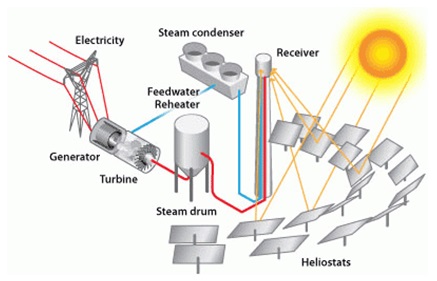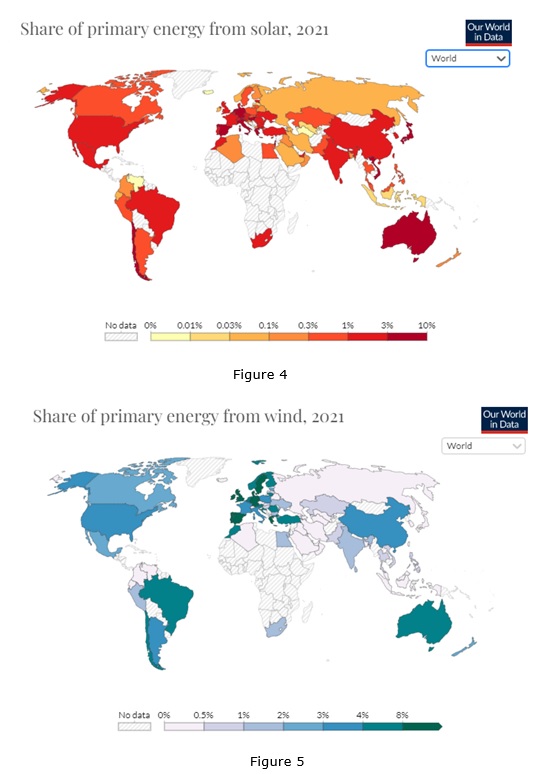Obtaining cheap and sustainable energy has always been an important task for humanity, and while for most of history people needed very little energy relative to today's world, because energy was mostly used for heating, cooking and handicraft production, people used mostly wood and also coal to satisfy these needs. However, things have changed since the first industrial revolution, with the development of steam engines and steam machines humanity has stepped into a new era, where an important role played by access to cheap energy, further with mass industrialization, electrification, massive population growth and rising living standards, the level of energy consumption has increased dramatically. Now mankind needs a huge amount of energy, in all industrialized countries the main type of energy that is generated is electrical energy, and then it is converted into other types of energy. However, the modern power industry is not only expected to produce cheap energy, but also to generate this energy with minimal environmental impact. Solar and wind energy are offten promoted as the main solution for this targets. So in this article I will try to look in detail at their strengths and weaknesses, as well as understand their technical structure.
Solar cell (Figure 1). A solar cell (also known as a photovoltaic cell or PV cell) is defined as an electrical device that converts light energy into electrical energy through the photovoltaic effect. A solar cell is basically a p-n junction diode. Solar cells are a form of photoelectric cell, defined as a device whose electrical characteristics – such as current, voltage, or resistance – vary when exposed to light. Individual solar cells can be combined to form modules commonly known as solar panels.
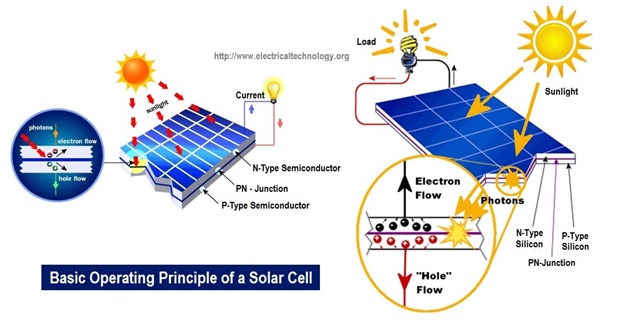
Figure 1
Principle of work. When light reaches the p-n junction, the light photons can easily enter in the junction, through very thin p-type layer. The light energy, in the form of photons, supplies sufficient energy to the junction to create a number of electron-hole pairs. The incident light breaks the thermal equilibrium condition of the junction. The free electrons in the depletion region can quickly come to the n-type side of the junction. Similarly, the holes in the depletion can quickly come to the p-type side of the junction. Once, the newly created free electrons come to the n-type side, cannot further cross the junction because of barrier potential of the junction. Similarly, the newly created holes once come to the p-type side cannot further cross the junction became of same barrier potential of the junction. As the concentration of electrons becomes higher in one side, i.e. n-type side of the junction and concentration of holes becomes more in another side, i.e. the p-type side of the junction, the p-n junction will behave like a small battery cell. A voltage is set up which is known as photo voltage. If we connect a small load across the junction, there will be a tiny current flowing through it.
Solar power sources also include Power tower concentrating solar power systems (Mirror power stations). Mirror power stations is a type of solar furnace using a tower to receive focused sunlight. It uses an array of flat, movable mirrors (called heliostats) to focus the sun's rays upon a collector tower (the receiver).
Principle of work (Figure 2). In power tower concentrating solar power systems, a large number of flat, sun-tracking mirrors, known as heliostats, focus sunlight onto a receiver at the top of a tall tower. A heat-transfer fluid heated in the receiver is used to heat a working fluid, which, in turn, is used in a conventional turbine generator to produce electricity. Some power towers use water/steam as the heat-transfer fluid. Other advanced designs are experimenting with high temperature molten salts or sand-like particles to maximize the power cycle temperature.
Figure 2
Wind turbines. Wind turbines work on a simple principle: instead of using electricity to make wind—like a fan—wind turbines use wind to make electricity. Wind turns the propeller-like blades of a turbine around a rotor, which spins a generator, which creates electricity.
Principle of work (Figure 3). A wind turbine turns wind energy into electricity using the aerodynamic force from the rotor blades, which work like an airplane wing or helicopter rotor blade. When wind flows across the blade, the air pressure on one side of the blade decreases. The difference in air pressure across the two sides of the blade creates both lift and drag. The force of the lift is stronger than the drag and this causes the rotor to spin. The rotor connects to the generator, either directly (if it’s a direct drive turbine) or through a shaft and a series of gears (a gearbox) that speed up the rotation and allow for a physically smaller generator. This translation of aerodynamic force to rotation of a generator creates electricity. The majority of wind turbines fall into two basic types: horizontal- and vertical-axis turbines. Wind turbines are also categorised according to where they are installed and how they are connected to the grid: land-based, offshore, distribured wind (Most turbines that used in distributed applications are small wind turbines) turbines.
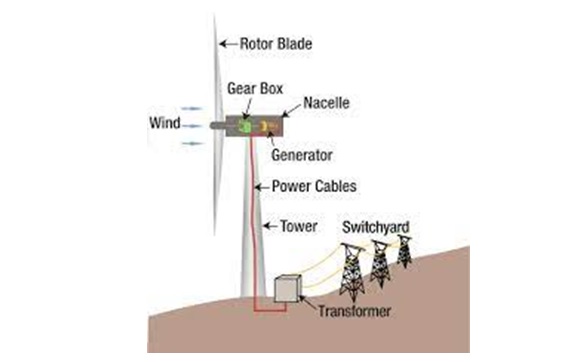
Figure 3
Disadvantages
1) The main disadvantage of solar and wind energy is the high cost of electricity for the end consumer and for production. In order to study this issue, I chose Germany as the subject of my research as it is at the forefront of introducing solar and wind energy into its electricity networks, what is shown on figures 4 and 5, it is also an extremely economically developed country with a huge industrial sector.
When we look at consumer prices on figure 6. in U.S. dollars per kilowatt hour, we see that electricity in Germany is the most expensive in the world after Denmark. This statistic does not only take into account the final price of electricity for the consumer, but also the subsidies that are taken from their taxes. In 2020, for example, the German government's subsidies for solar and wind energy amounted to USD 38 billion.
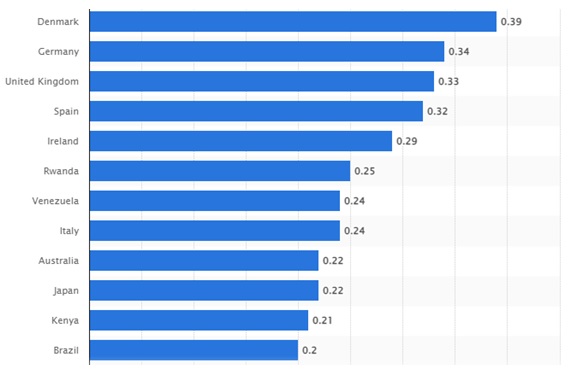
Figure 6
2) Also a serious disadvantage is the unstable operation of these sources of electricity, as in cloudy weather and at night solar power sources do not provide this very energy, exactly as wind generators do not provide electricity when there is no wind. To compensate for this, Germany uses fossil fuel backup power and special batteries to store the energy generated, but these batteries are made of extremely toxic materials like lead and are also extremely expensive to maintain, so scientists around the world are trying to come up with new types of batteries to solve these problems, for example based on graphene.
3) It should also be kept in mind that in order to provide a large community with electricity, using solar and wind energy alone, a considerable area of land would need to be set aside that could be used for other possibilities, such as agriculture for example.
4) Another serious problem is the disposal of waste blades of wind turbines and solar panels, because solar panels contain toxic materials and wind turbine blades are mostly just buried because there is no full-fledged way of recycling them.
5) The disadvantages of wind turbines in particular are that they cause the death of birds and emit noise pollution.
Advantages
1) No emissions during electricity generation
2) Very suitable for installation in remote areas and private homes, for the provision of an independent electricity generation
Conclusion
Solar and wind power are environmentally friendly forms of power generation, but they have a number of serious disadvantages that cannot be solved in the near future. The question of whether these disadvantages can be accepted or not, I will leave to the readers of this article.
The list of sources used:
https://ourworldindata.org/renewable-energy [Last seen : 29.09.2022]
https://en.wikipedia.org/wiki/Photovoltaic_power_station [Last seen : 29.09.2022]
https://www.electrical4u.com/solar-cell/ [Last seen : 29.09.2022]
https://www.apogeeweb.net/article/27.html [Last seen : 29.09.2022]
https://www.energy.gov/eere/wind/how-do-wind-turbines-work [Last seen : 29.09.2022]
https://en.wikipedia.org/wiki/Solar_power_tower [Last seen : 29.09.2022]
https://www.energy.gov/eere/solar/power-tower-system-concentrating-solar-thermal-power-basics [Last seen : 29.09.2022]
https://news.infocar.ua/v_avstralii_sozdali_novyy_vid_akkumulyatorov_oni_zaryajayutsya_v_60_raz_bystree_litiy-ionnyh_143316.html [Last seen : 29.09.2022]
https://www.bloomberg.com/news/articles/2021-01-12/germany-paid-record-38-billion-for-green-power-growth-in-2020?leadSource=uverify%20wall [Last seen : 29.09.2022]
https://www.obozrevatel.com/green/wind-power/kladbische-vetra-v-ssha-nashli-poligon-dlya-utilizatsii-gigantskih-vetrogeneratorov.htm [Last seen : 29.09.2022]
|









